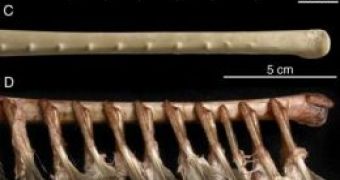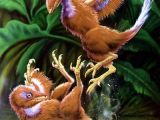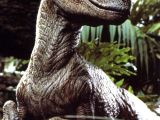Birds are dinosaurs; or is it?some dinosaurs were in fact birds? It's quite difficult to answer this question, but what's certain is that many carnivorous dinosaurs were feathered. Some of the feathered dinosaurs were even as big as a rhino. However, few dino fossils discovered up to now were feathered.
A new research made by a team at the American Museum of Natural History and the Field Museum of Natural History now the presence of feathers has been proven on one of the Jurassic Park's stars, the Velociraptor (which in fact, lived in the Cretaceous era, not in the Jurassic), and which was closely related to the birds.
The investigated fossil bone is a Velociraptor forearm dug in 1998 in Mongolia. The bone clearly had quill knobs, bony bumps to which the large secondary feathers of the wing, involved in flight in modern birds, are attached to the bones with ligaments. Many living birds have quill knobs, which are the most evident species with strong flight.
"A lack of quill knobs does not necessarily mean that a dinosaur did not have feathers. (But) Finding quill knobs on velociraptor, though, means that it definitely had feathers. This is something we'd long suspected, but no one had been able to prove," said lead author Alan Turner, a graduate student of paleontology at the American Museum of Natural History and at Columbia University in New York.
Most feathered dinosaur fossils encountered so far came from a special type of lake sediment that favored their preservation (both of the feathers and of the small-bodied animals).
The Velociraptor itself was a small species, up to 2.07 m (6.7 ft) long (over half of which was the long tail) and weighing 15 kg (33 lb). The individual in the current research was about 1.5 m (5 ft) long, and weighed about 13.5 kg (30 lb). But the relatively short forelimbs compared to modern flying birds discard it as a flying dinosaur.
The research team believes that the Velociraptor could have evolved from a flying ancestor, from which it kept its feathers, that could have been employed for display, egg incubation, homeothermy (temperature control), or in maneuvers during running. "The more that we learn about these animals the more we find that there is basically no difference between birds and their closely related dinosaur ancestors like Velociraptor," said co-author Mark Norell, a Curator in the Division of Paleontology at the American Museum of Natural History.
"Both have wishbones, brooded their nests, possess hollow bones, and were covered in feathers. If animals like Velociraptor were alive today our first impression would be that they were just very unusual looking birds".

 14 DAY TRIAL //
14 DAY TRIAL // 

